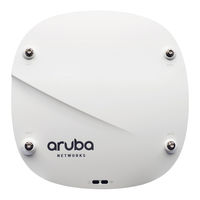User Manuals: ARUBA IAP-315 Wireless Access Point
Manuals and User Guides for ARUBA IAP-315 Wireless Access Point. We have 2 ARUBA IAP-315 Wireless Access Point manuals available for free PDF download: User Manual, Installation Manual
ARUBA IAP-315 User Manual (438 pages)
Instant software
Brand: ARUBA
|
Category: Wireless Access Point
|
Size: 7.6 MB
Table of Contents
-
-
Instant UI14
-
Instant CLI15
-
-
IAP Cluster20
-
-
Main Window32
-
Banner32
-
Tabs32
-
Network Tab33
-
Clients Tab34
-
Links34
-
System35
-
Rf35
-
Security36
-
Maintenance36
-
Vpn37
-
Ids37
-
Wired39
-
Services39
-
DHCP Server40
-
Help41
-
Logout41
-
RF Dashboard43
-
RF Trends45
-
Usage Trends47
-
Client Match51
-
Apprf51
-
Spectrum51
-
Alerts52
-
Alerts List54
-
Airgroup57
-
Pause/Resume58
-
Views58
-
-
-
-
VLAN Pooling77
-
-
-
Multi-User-MIMO105
-
-
-
-
User Privileges143
-
Adding a User144
-
-
-
TACACS Servers155
-
-
-
-
User Role206
-
-
-
L2Tpv3 Tunneling235
-
-
-
-
Local Mode243
-
Local, L2 Mode243
-
Local, L3 Mode243
-
-
Branch Details251
-
ARM Overview253
-
-
-
-
-
Apprf Dashboard265
-
-
-
Voice and Video
276 -
Services
282-
ALE with Instant292
-
-
Image Management305
-
-
Resetting an IAP305
-
Trending Reports306
-
Shared Key308
-
Airwave—Monitor314
-
-
Uplink Types317
-
-
Uplink Status318
-
Cellular Uplink319
-
Wi-Fi Uplink321
-
-
Configuring IDS333
-
Mesh Portals334
-
Spectrum Monitor
340-
Upgrading an IAP348
-
IAP Maintenance
348 -
-
Configuring SNMP360
-
Syslog Server364
-
Logging Levels365
-
-
NAI Realm List374
-
Venue Types377
-
-
-
-
Troubleshooting394
-
-
Advertisement
Aruba IAP-315 Installation Manual (17 pages)
Brand: Aruba
|
Category: Wireless Access Point
|
Size: 2.67 MB
Table of Contents
-
China Rohs10

